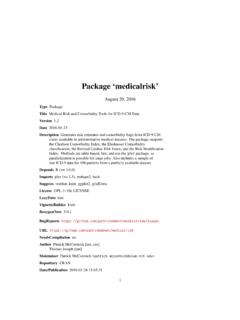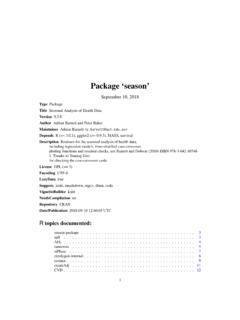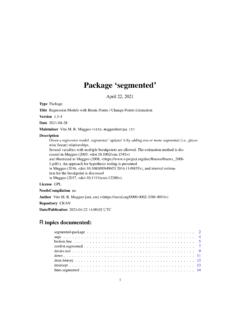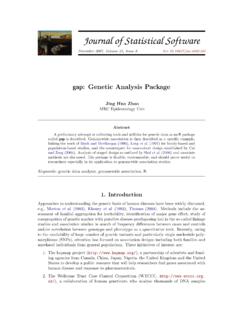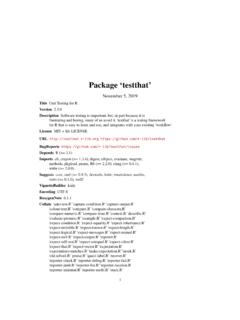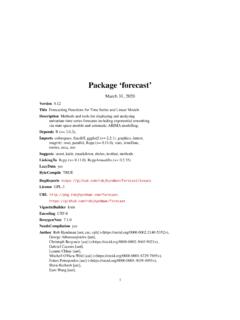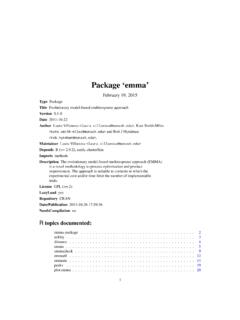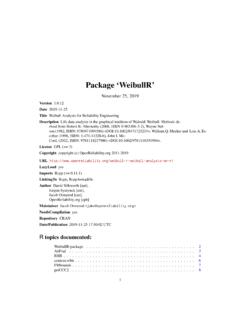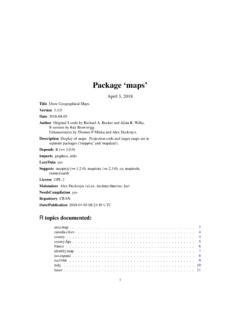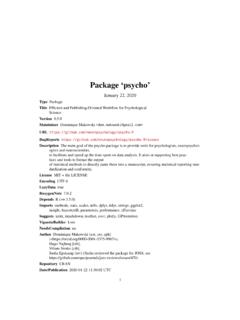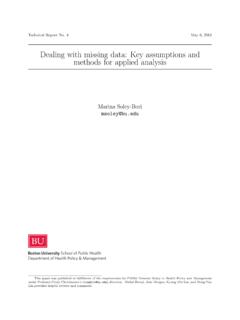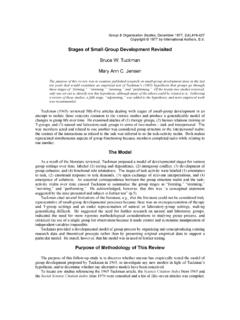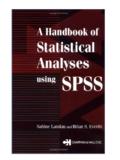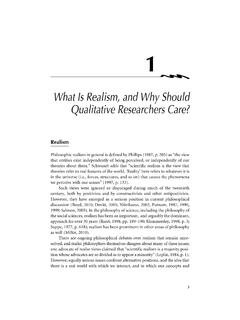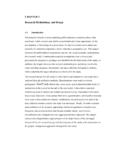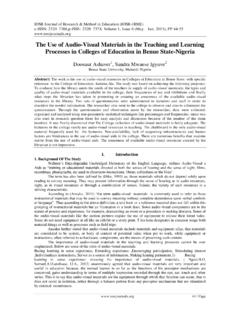Transcription of Statistics Using R with Biological Examples
1 Statistics Using R. with Biological Examples Kim Seefeld, MS, *. Ernst Linder, University of New Hampshire, Durham, NH. Department of Mathematics & Statistics *Also affiliated with the Dept. of Nephrology and the Biostatistics Research Center, Tufts-NEMC, Boston,MA. Copyright May 2007, K Seefeld 1. Permission granted to reproduce for nonprofit, educational use. Preface This book is a manifestation of my desire to teach researchers in biology a bit more about Statistics than an ordinary introductory course covers and to introduce the utilization of R as a tool for analyzing their data . My goal is to reach those with little or no training in higher level Statistics so that they can do more of their own data analysis, communicate more with statisticians, and appreciate the great potential Statistics has to offer as a tool to answer Biological questions. This is necessary in light of the increasing use of higher level Statistics in biomedical research.
2 I hope it accomplishes this mission and encourage its free distribution and use as a course text or supplement. I thank all the teachers, professors, and research colleagues who guided my own learning especially those in the Statistics and Biological research departments at the University of Michigan, Michigan State University, Dartmouth Medical School, and the University of New Hampshire. I thank the Churchill group at the Jackson labs to invite me to Bar Harbor while I was writing the original manuscript of this book. I especially thank Ernst Linder for reviewing and working with me on this manuscript, NHCTC for being a great place to teach, and my current colleagues at Tufts-NEMC. I dedicate this work to all my students past, present and future both those that I teach in the classroom and the ones I am teaching through my writings. I wish you success in your endeavors and encourage you never to quit your quest for answers to the research questions that interest you most.
3 K Seefeld, May 2007. Copyright May 2007, K Seefeld 2. Permission granted to reproduce for nonprofit, educational use. 1. Overview The coverage in this book is very different from a traditional introductory Statistics book or course (of which both authors have taught numerous times). The goal of this book is to serve as a primer to higher level Statistics for researchers in Biological fields. We chose topics to cover from current bioinformatics literature and from available syllabi from the small but growing number of courses titled something like Statistics for Bioinformatics . Many of the topics we have chosen (Markov Chains, multivariate analysis) are considered advanced level topics, typically taught only to graduate level students in Statistics . We felt the need to bring down the level that these topics are taught to accommodate interested people with non- statistical background. In doing so we, as much as possible, eliminated Using complicated equations and mathematical language.
4 As a cautionary note, we are not hoping to replace a graduate level background in Statistics , but we do hope to convey a conceptual understanding and ability to perform some basic data analysis Using these concepts as well as better understand the vocabulary and concepts frequently appearing in bioinfomatic literature. We anticipate that this will inspire further interest in statistical study as well as make the reader a more educated consumer of the bioinformatics literature, able to understand and analyze the statistical techniques being used. This should also help open communication lines between statisticians and researchers. We (the authors) are both teachers who believe in learning by doing and feel there would be little use in presenting statistical concepts without providing Examples Using these concepts. In order to present applied Examples , the complexity of data analysis needed for bioinformatics requires a sophisticated computer data analysis system.
5 It is not true, as often misperceived by researchers, that computer programming languages (such as Java or Perl) or office applications (such as spreadsheets or database applications) can replace a Copyright May 2007, K Seefeld 3. Permission granted to reproduce for nonprofit, educational use. statistical applications package. The majority of functionality needed to perform sophisticated data analysis is found only in specialized statistical software. We feel very fortunate to be able to obtain the software application R for use in this book. R has been in active, progressive development by a team of top-notch statisticians for several years. It has matured into one of the best, if not the best, sophisticated data analysis programs available. What is most amazing about R is that it completely free, making it wonderfully accessible to students and researchers. The structure of the R software is a base program, providing basic program functionality, which can be added onto with smaller specialized program modules called packages.
6 One of the biggest growth areas in contributed packages in recent years has come from bioinformatics researchers, who have contributed packages for QTL and microarray analysis, among other applications. Another big advantage is that because R is so flexible and extensible, R can unify most (if not all) bioinformatics data analysis tasks in one program with add-on packages. Rather than learn multiple tools, students and researchers can use one consistent environment for many tasks. It is because of the price of R, extensibility, and the growing use of R in bioinformatics that R. was chosen as the software for this book. The disadvantage of R is that there is a learning curve required to master its use (however, this is the case with all statistical software). R is primarily a command line environment and requires some minimal programming skills to use. In the beginning of the book we cover enough ground to get one up and running with We are assuming the primary interest of the reader is to be an applied user of this software and focus on introducing relevant packages and how to use the available existing functionality effectively.
7 However, R is a fully extensible system and as an open source project, users are welcome to contribute code. In addition, R is designed to interface well with other technologies, including other programming languages and database systems. Therefore R will appeal to computer scientists interested in applying their skills to statistical data analysis applications. Now, let's present a conceptual overview of the organization of the book. The Basics of R (Ch 2 5). This section presents an orientation to Using R. Chapter 2 introduces the R. system and provides guidelines for downloading R and obtaining and installing packages. Chapter 3 introduces how to work with data in R, including how to manipulate data , how to save and import/export datasets, and how to get help. Chapter 4 covers the rudimentary programming skills required to successfully work with R and understand the code Examples given in coming chapters.
8 Chapter 5 covers basic exploratory data analysis and summary functionality and outliners the features of R's graphics system. Copyright May 2007, K Seefeld 4. Permission granted to reproduce for nonprofit, educational use. Probability Theory and Modeling (Ch 6-9). These chapters are probably the most theoretical in the book. They cover a lot of basic background information on probability theory and modeling. Chapters 6-8 cover probability theory, univariate, and multivariate probability distributions respectively. Although this material may seem more academic than applied, this material is important background for understanding Markov chains, which are a key application of Statistics to bioinformatics as well as for a lot of other sequence analysis applications. Chapter 9 introduces Bayesian data analysis, which is a different theoretical perspective on probability that has vast applications in bioinformatics.
9 Markov Chains (Ch 10-12). Chapter 10 introduces the theory of Markov chains, which are a popular method of modeling probability processes, and often used in Biological sequence analysis. Chapter 11 explains some popular algorithms the Gibbs sampler and the Metropolis Hastings algorithm that use Markov chains and appear extensively in bioinformatics literature. BRugs is introduced in Chapter 12. Using applied genetics Examples . Inferential Statistics (Ch 13-15). The topics in these chapters are the topics covered in traditional introductory Statistics courses and should be familiar to most Biological researchers. Therefore the theory presented for these topics is relatively brief. Chapter 13. covers the basics of statistical sampling theory and sampling distributions, but added to these basics is some coverage of bootstrapping, a popular inference technique in bioinformatics. Chapter 14 covers hypothesis testing and includes instructions on how to do most popular test Using R.
10 Regression and ANOVA. are covered in Chapter 15 along with a brief introduction to general linear models. Advanced Topics (Ch 16-17). Chapter 16 introduces techniques for working with multivariate datasets, including clustering techniques. It is hoped that this book serves as a bridge to enable Biological researchers to understand the statistical techniques used in these packages. Copyright May 2007, K Seefeld 5. Permission granted to reproduce for nonprofit, educational use. 2. The R Environment This chapter provides an introduction to the R environment, including an overview of the environment, how to obtain and install R, and how to work with packages. About R. R is three things: a project, a language, and a software environment. As a project, R is part of the GNU free software project ( ), an international effort to share software on a free basis, without license restrictions. Therefore, R does not cost the user anything to use.
